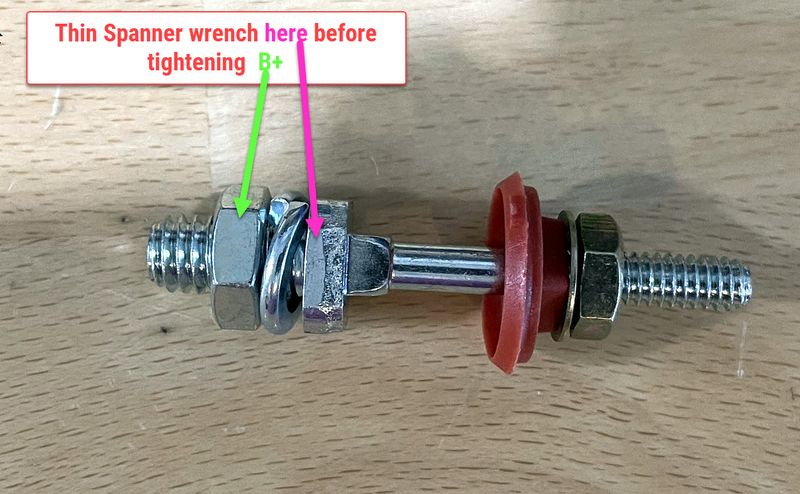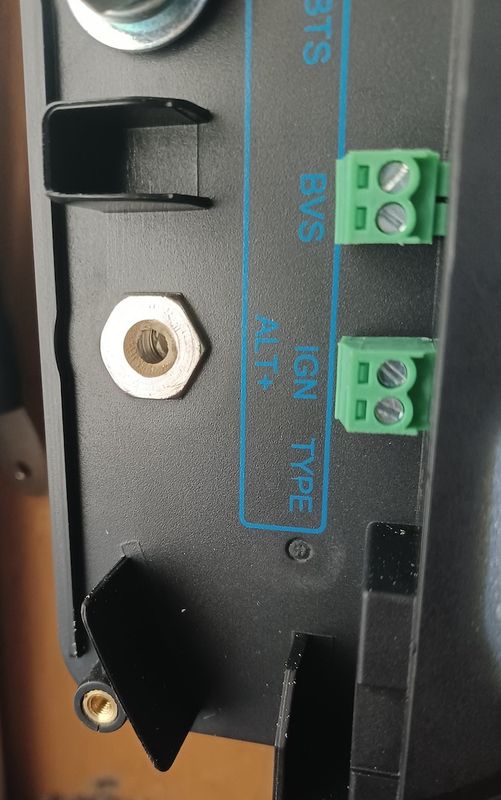How To Identify Balance Issues in LiFePO4
Hope this helps!
Hope this helps!
This section allows you to view all posts made by this member. Note that you can only see posts made in areas you currently have access to.
Show posts Menu
Quote from: ewengstrom on July 26, 2023, 08:41:23 AMI don't have any rectifiers left we had to order them 300 at a time and we were about to place an order when I had to close my business. My buddy Gene who used to be at Regitar left and joined another company..
Rod,
Giving your replies a good bit of thought I'm inclined to agree that this problem may have been of my own making. I've never had to worry about using a spanner wrench when tightening the nut on the B+ post anytime in the past....but honestly, this explanation makes sense. I also hope this thread helps folks figure out something like this in the future.....it really is quite frustrating.
I'm also going to take a hard look at the cable itself as it is not attached to the engine anywhere other than the B+ post and I'm wondering if when the motor vibrates at lower RPM's it is actually working the post around inside the alternator. Once I get back to reinstalling the alternator I'll address this possibility and report back on the findings.
By some chance might you have one of the original 70A rectifiers and a B+ post assembly for the AMPIT-100-ER available? I'd very happily purchase it from you rather than attempt to source it elsewhere.
Quote from: ewengstrom on July 25, 2023, 12:33:15 PM
Hey Rod, there was no model number on the old one, I ended up using a DR5042 as a replacement.
I've been quite careful when tightening anything on the alternator, I didn't want a repeat....I didn't see any evidence of loctite on the nut for the rectifier but I'm curious if that would be something to avoid...or is it a good idea?
My battery bank is four Trojan 6V batteries.

Quote from: ewengstrom on July 25, 2023, 04:27:47 AMWhat model # rectifier did you replace it with? When tightening B+ a thin spanner wrench should be used to prevent the B+ stud from spinning. If you twist it when tightening B+ it can come loose at the rectifier end. What batteries are you charging?
Apologies for the long post...I type very fast.....
Last year I'd posted on a thread that Alex started about his alternator puking and reported that my practically new alternator had also puked, the cause was that the nuts securing the positive post to the rectifier had loosened up inside the alternator (it's an AMPIT-100-ER from Compass Marine) and it started arcing. Since I was away from home on day 2 of a 17 day trip, I was able to clean it up and tighten the nuts down again and continued on my merry way. When I got home I removed the alternator and replaced the partially melted rectifier and nuts and it's been fine....for exactly one year.
This past weekend the exact same thing happened....the tach started dropping to zero.....then it would pop back up....over and over. I shut the engine down and started poking around and once again I found the positive post had loosened up inside the alternator and the arcing has fried the new rectifier.
I'm at a bit of a loss, the system is practically new, I'm using a Balmar 614 regulator with alternator temp sensor and all the wiring in the charging circuit is new and appropriately sized. I can't help but to wonder if there is some sort of heat issue going on with the alternator that is causing these nuts to back off and hence causing the arcing.
I don't want to give up on this alternator, Rod built it and I'm confident it is still good...once I put a new rectifier in it that is.....but I also don't want to replace rectifiers every year either.
Anyone come upon this type if issue before and if so, what was your cure????
Quote from: senorquill on March 03, 2023, 12:43:53 PM
That was just an example for their Solar Panels, has nothing to do with the batteries. I'm not an electrician but I can research tech stuff and I do that for the Air Force. There are many other options out there beside the 2 in this thread, so you should do your own homework.
QuoteRengoy and Epoch battery cells are both made in China. Which manufacture is better, I have no clue. Epoch, gets cells from EDG Sales International in Zhongkai High-Tech District, Huizhou, Guangdong, China. Renogy gets them from Hefei, Anhui, China.
QuotePrismatic cells are more inclined to "Explode" due to the metal casing.Pouches are less inclined./quote]
I anxiously await the data to back either of these two claims. I was recently hired as an expert witness by an an insurance company in a case where pouch cells were torn by their fixing jig inside the battery. Not LFP but still pouch cells.QuoteAll I was trying to say was "By Far" better than any other battery seemed overzealous. Neither Renogy or Epoch are dominated the market right now, LOL.
Of course not Epoch are new and were purposely designed to solve previous issues.. Li Time are currently the #1 selling LFP battery due to price. You can always find cheaper but you will be hard pressed to find a better constructed or better value battery.. I welcome you showing use a battery that checks all the boxes the Epoch does for less money. I wish you luck with your Renogy batteries and cross my fingers that you never need customer service or support.

Quote from: senorquill on February 08, 2023, 09:51:07 PMQuote from: tmac on February 08, 2023, 06:14:20 PM
I'm going to venture forth with my opinions on this subject even though some may not agree. I'm right in the middle of reconfiguring my boat's battery and charging systems to incorporate LiFePO4 for the house bank. My recommendations to MQ are as follows:
1.First, spend some more time educating yourself about incorporating Lithium. As Maine Sail says, Lithium is not a drop-in replacement for lead acid. There's more to consider than you see at first glance. I'd recommend watching the video seminars on YouTube from Pacific Yacht Systems (Jeff Cote) on the subject (yes, I know, he's long winded, but there's good information in there.) Also Maine Sail has several good write-ups, as well as Nigel Calder's extensive writings and his videos on YouTube.
2.One of the above authors made a good analogy, which was that LiFePO4 batteries are like marathon runners, and lead-acid starter batteries are like sprinters. Starting an engine requires a sprinter – big push for a short duration. This is not what LiFePO4 batteries are designed for. They are good at providing a strong, steady output for long periods of time. The three authors above all seem to agree that using a LiFePO4 battery as a starter battery on a regular basis is not recommended.
3.You mentioned that you were going to have the DC to DC charger charging the starter battery from the house bank. In my opinion, that's backwards. Unless you are also using solar, the DC charger only comes into play when you are charging via the alternator. When you crank the engine, you are only draining the starter battery by a couple of percent in most cases, unless your engine requires some serious maintenance. (This is why most internally regulated alternators have a VERY conservative charging profile – it only takes a few minutes to fully recharge the starter battery.) So to me, it makes more sense to have the DC charger look to see when the starter battery has 13.6 V on it (i.e. it is being charged by the alternator), and draw from that side to also charge the house bank, which will likely be in more need of charging. The starter battery will be recharged in short order, and then the DC charger and alternator can focus on the house bank.
4.There are many misconceptions about Lithium batteries – especially the issue with flammability. Maine Sail does a good job of putting this to rest (as does Nigel Calder), clarifying that the LiFePO4 battery is very different that the earlier Lithium Ion batteries that made the news so often. The primary concern for fire with LiFePO4 would actually come from situations where a dead short in wiring occurred that would allow the battery to pump out vast amounts of current, melting the wiring. However most of the batteries being sold today have battery management systems that would shut down the battery in these situations. That BMS, combined with an appropriate Class T fuse in the main wiring configuration should greatly reduce this risk. The other situation to guard against is using a 1/2/both switch and combining a heavily discharged starter battery with a fully charged LiFePO4 bank. The large voltage difference would cause a big current spike, and again could lead to a wiring meltdown. In my configuration, I'm using a keyed switch hidden away from passengers that will allow me in an emergency use my house bank for starting the engine, but only after I first pull the fuse on the starter battery so that the two banks are never linked.
That's my nickel's worth. Is it worth installing LiFePO4? I think so – for nearly the same cost as replacing my 4 dying Trojan T-105's I'm getting about 220 amp hours, of which I can actually use about 175 AH on a regular basis (and more if I really need), whereas the Trojans gave me 420 AH, but I could only use about 35% of that on a regular basis or 147 AH (sometimes 200 AH if I pushed it hard, but you pay a price in longevity for that). Not to mention the far longer lifespan for the LiFePO4. And I can fit the two lithium batteries easily into the battery box, with enough room to also mount the DC to DC charger in there and do a nice, neat wiring job for my main unswitched bus, fuses, etc.
OK – I've stepped down off my soapbox...
Tom,
Thanks for the great advice. After a ton more research and contacting Renogy it sounds like the 100A a LiFePO4 produces will not work for engine crank ups, so I'll be going with a 2x 100Ah LiFePO4 House Bank and 1x 105Ah AGM starter bank with DC to DC charger option from the starter bank to the house bank.
------------
I've been watching Pacific Yacht Systems and that's where I got the idea for the DC to DC charger. You are correct about the DC to DC going from the Starter Battery to the House Bank, I miss spoke. That's is what I intend on doing. I have 200 watts of solar also, which I could re wire to the starter battery in the event the alternator craps out and I need the starter battery at full power.
MQ
Quote from: britinusa on February 13, 2023, 07:14:41 AM
Just spoke with Mike at Balmar ( thanks for the ph# Ron )
The Balmar 48-USP-M25 is the appropriate Serpentine Belt Kit for the Universal M25-XP
:)
Paul